Guide Dogs
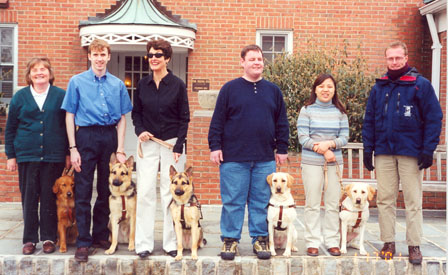
Here I am with Handley among my Seeing Eye classmates, their guide dogs and our instructor, Australian Peter Tomlins, January 2001.

Here I am with Handley among my Seeing Eye classmates, their guide dogs and our instructor, Australian Peter Tomlins, January 2001.
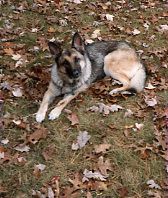
I trained with Marit, my first female German shepherd guide, in October 1978. Marit was my most headstrong dog, all 80 pounds of her testing me every minute of our first six weeks together. In the training program and in Pittsburgh, Marit didn’t want to stop at streets. She didn’t give proper clearance and banged my right shoulder, arm, and hip into telephone poles, door jams, and walls. I disciplined her so often for these mistakes that Marit decided to lie down before every entrance, every space that seemed too narrow. Fortunately, she only bashed my right side, not my tummy. Maybe she understood that I was pregnant with Leslie. After two weeks in Pittsburgh, Marit learned to clear enough space for herself and me. Except for her determination to eat cats, she developed into an angelic guide dog. My son Joel was two when Marit joined our family. He was fascinated by Marit’s tall, pointy ears and loved to bite them. Marit yelped, but never snapped or growled at Joel. After Leslie learned to crawl, she often stood on top of Marit to see out a window. Marit bore it with great saintliness. She absolutely thought she was Leslie’s and Joel’s mother.
Marit also saved my life. On the way home one day, Marit suddenly shoved her back side into me, pushing me backwards. Just as I scolded her, I heard a car, charging up the driveway, right at us. I ran into the empty street with Marit, and the car’s rear bumper knocked my back legs, propelling me forward. Marit could have broken away from me and saved herself, but she took time to rescue me, too.
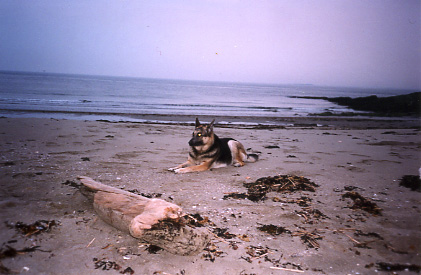
Ursula, another female shepherd, possessed Marit’s loving, loyal nature. But where Marit could be aggressive to cats and assertive when any other dog attacked, Ursula was a complete pacifist, some might say a coward. She was terrified of thunder and trembled well before the storm hit and well afterward. After two smelly Afghan hounds attacked her at an intersection one day, she lay on the sidewalk shrieking like a smoke alarm. In her defense, I swung at the dogs and would have swung at the negligent owner, if I could have found him. Fortunately, he came slinking over quietly and pulled his dogs away, but every pedestrian on the sidewalk screamed at him. From then on, Ursula was terrified of dogs, even those half her seventy-pound size. After a year of soothing and desensitizing, she overcame her fear, at least of other dogs.
As angelic as Ursula was, she did have a sneaky mischief about her. All my dogs have stolen food and crept on beds and furniture, slipping off ever so quietly when they hear me coming. I know they’ve misbehaved by the warmth of the mattress or cushion! But Ursula was probably my cleverest canine sneak. One day she chewed the contents of a waste basket, so I scolded her. The next day I couldn’t find her to go out for an errand. I called and called, then thought she’d somehow slipped outside with my kids and their friends, something she’d never done before. Joel and Leslie didn’t know where she was, and they headed out on bikes in search of her. I phoned neighbors and really began to worry. Was she lost? No! When Joel came back, he found her lying in his bedroom beside the same waste basket she’d delved into the day before. I’d stepped into that bedroom and called her, but she hadn't made a peep. She knew I wouldn't find her and scold her again if she kept perfectly quiet .
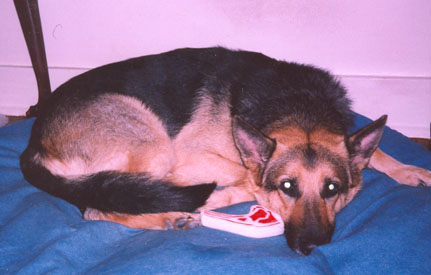
Handley, my shrimpiest German shepherd arrived in Pittsburgh, January 2001. Ursula, now retired because of her returning cancer, ran out to greet me, and the two dogs sniffed each other without any regard to good manners. Bob took Ursula for a brief walk while Handley acquainted herself with the house. When Ursula again ran up to me, Handley growled like thunder. Ursula, fifteen pounds heavier, fled from the room. I scolded Handley and coaxed Ursula back, but Handley barked and behaved like a total brat. Within two days, however, Ursula quietly stole Handley’s food, toys, and dog bed. When I put the harness on Handley, Ursula tried to place her own head in the harness instead. I felt so sad, but realized if I walked Ursula first for just a minute or two, Ursula was happy to sleep while Handley worked. Ursula’s health was really slipping. Her nose bled steadily, because of the tumor in her left nostril. I confined her to Bob’s and my bedroom. Once, I realized Ursula had a nose bleed because Handley stood over Ursula, licking her nose.
Handley was so energetic. When out of harness, she seldom walked if she could leap and bolt and blast around the house. At Seeing Eye, she could be very aggressive in play with other dogs, growling, barking, and nipping, if allowed. But with Ursula, she was very gentle. She seemed to understand that her older friend was sick. When Ursula died, Bob and I were grief-stricken. But Handley was worse. She wouldn’t go into the bedroom where she’d spent each evening, keeping Ursula company. She kept jumping up on me, seeming to ask, “Where’s Ursula?”
Ursula has been gone since August, 2001. Handley is used to being the queen of the household. Of all my dogs, she is the most affectionate, always needing to rest up against my leg, always wanting to sit in my lap. Of course, she doesn’t quite fit. Still, she perches there and allows me to pat her. She’s very intense and wants to be in the lead everywhere, first out the door and in the door. If Bob waits for me in front of the house, Handley nearly flies to the car. I have to scold and make her repeat the walk until she guides me safely.
Enthusiasm is both her greatest strength and her greatest weakness. She expresses that enthusiasm very vocally and both talks and sings. Sometimes she impersonates a cow, mooing and moaning, especially in the most brilliant parts of my speeches. Finally, she’s very destination-oriented. If I go somewhere once, Handley turns to that door the next time we pass it. I always pat and thank her, then say, “Hup-up,” to make her continue along the route. But Handley often resists leaving, since she’s convinced she knows better than I do where I want to go. We argue, and she complies, against her better judgment.
Three times in the summer of 2008, I thought Handley was dying. She stopped eating and drinking and lay in a lethargic lump on the floor. Although the vets had ruled out Cushings’ Disease, her tail, neck, and tummy, plus much of her rump were bald. We gave her new tests and finally agreed to the vet’s recommendation to start her on thyroid medicine, even though her tests didn’t suggest thyroid disease. We also put her on an arthritis pill twice daily. Still, the fact confronted me; her guiding days were done. My fall schedule was very busy, and I wanted to give Handley’s medicine a chance to work, just in case I was wrong about retiring her. Even though she remained embarrassingly bald, by late October, she seemed much livelier. The arthritis medicine made her feel better, but she lacked the stamina for more than short walks. On January 5, 2009, I smooched her between the eyes. “You’re my best girl,” I whispered and boarded the plane to Seeing Eye.
I brought Flossie to Pittsburgh on January 16, 2009 with only one concern: how Handley would accept her replacement. I expected Flossie to take to her new routes comfortably. All through training, she had been my easiest dog, leading me smoothly through every lesson. She didn’t have Marit’s testing behavior, Ursula’s timidity, or Handley’s intensity. She seemed calm and loving and behaved perfectly on the plane and in the strange airports.
One day home, then two, without war. Flossie licked Handley’s face, while Handley drank Flossie’s water and took over Flossie’s crate. Alpha dog established! And because Handley accompanied Bob, Flossie, and me for coffee and lunch, she didn’t show any jealousy of the cheerful, much bigger Flossie. A Seeing Eye instructor arrived on January 19 to help orient Flossie and me for the next three days, and I predicted nothing but triumph.
But the temperature dipped to minus 6 degrees, and five inches of snow fell overnight. Although Flossie probably played in snow as a pup, she’d never learned to guide in it. Our first trips with the instructor were disasters, with her crossing streets into oncoming traffic to avoid the snow. After many corrections, she grew timid and just wanted to get out of the miserable stuff. She guided me up sidewalks to strangers’ houses.
Flossie’s mistakes shocked and worried me. Seeing Eye trainers say that drivers have grown more aggressive recently. Right turns on red and cell phone use make crossing streets riskier. But drivers cut off dogs now, the way they cut off pedestrians; they think guide dogs are flawless machines, not dogs. The result: blind people still get injured and killed by cars.
And Flossie doesn’t have Handley’s photographic memory for destination. The combination of ice, snow, Flossie’s newness, and my hearing loss created problems.
On one trip to the grocery store, for instance during a slow-traffic time, I didn’t think Flossie had walked completely to the intersection. With the ramped curb cuts, it’s often impossible to feel the distinction between street and sidewalk. Add frozen, unshoveled snow to the mix, and all tactual clues disappear.
“Hup-up,” I told Flossie, and she took three more steps.
“Right,” I said, and she obeyed.
After we’d trotted along for about fifty feet, a man called to me, “Excuse me, but you do know you’re in the street.”
No, I didn’t know. Flossie had done exactly what I’d commanded. Possibly she should have known not to saunter along the middle of Murray Avenue, but we’d stepped into my street several times that day to avoid the garbage cans, so she didn’t think my order was strange.
“Do not catastrophize,” I told myself. The coordination with my other dogs hadn’t happened overnight either. I headed to the next intersection and the next to get to the grocery store. Bingo! We made it. “Turn each goof into a learning experience,” I mumbled, handing Flossie a treat.
On the way home from the store, I realized I could hear my footsteps echo off the building. If I landed in the middle of the street again, I wouldn’t detect those looming stores. “I have to be alert every moment,” I told Flossie and felt her nod.
Since that mistake, I chose to review routes in a methodical way, repeat them often and reward Flossie with treats when she corrected a former blunder. Many Seeing Eye grads go each day to their work sites and home, giving their guides numerous opportunities to repeat and master a route. Their dogs learn a variety of routes, of course, but I erred in giving Flossie so many routes at once. With the snow and my hearing deficit, I confused her.
For months now, we haven’t made any dangerous errors, despite at least two trips a day. Our confidence has grown, and so has our pride. We are on our way.
Every Saturday morning, Flossie and I take the long way and meet Bob and Handley at our favorite coffee shop. Flossie rests her chin on my left knee, and Handley, now full-coated from her thyroid pills and promising a few more years of companionship, puts her head on my right. At those moments, I sip coffee while the enormous effort in making this mobility system work drifts away. Flossie, Handley, and I are a trio, and I feel like the luckiest person in the world.
Until April 3, 2010. Handley seemed short of breath. For five months she had been weakening,having trouble standing onher own. But this whole week she had seemed to be suffering, too pained by her arthritis to get up by herself. I sat with her and stroked and talked to her. Finally I had to give Flossie her morning walk, so I put on classical music, lit a scented candle and opened the window to allow the wonderful breeze to blow gently over her. “Be back in a half hour, Girl Friend,” I said and rested my forehead on hers. When I returned, she had died.
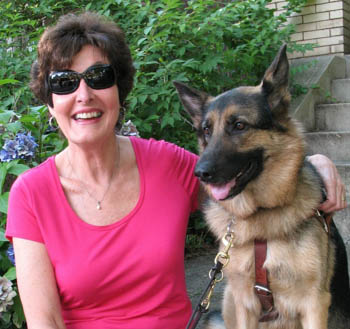
Flossie definitely missed Handley, but soon adjusted to being the main pooch in the house. She guided me beautifully, despite a murderous dislike of cats. I slid a gentle leader around her nose and behind her ears, and that prevented her from lunging after them.
On February 15, Bob and I returned from an afternoon play, and Flossie greeted us. Immediately, though, she began to shake her head so that her collar jingled. She sat on her kitchen mat and then scrambled to stand. I heard her toenails on the tile and hurried to her. One touch and I realized she was fighting to stand. As I lifted her to all-fours, her back legs splayed out and couldn’t hold her. Flossie had had a stroke. The emergency room vet told us that they’d found a tumor in her heart. The tumor had burst, and three hours later, Flossie died.
Bob and I were shocked and heartbroken. Flossie was only 8 years old. I’d hoped to walk beside her for another two or three years.
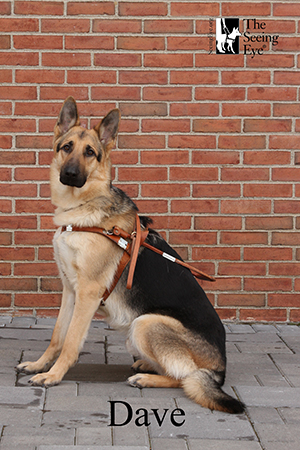
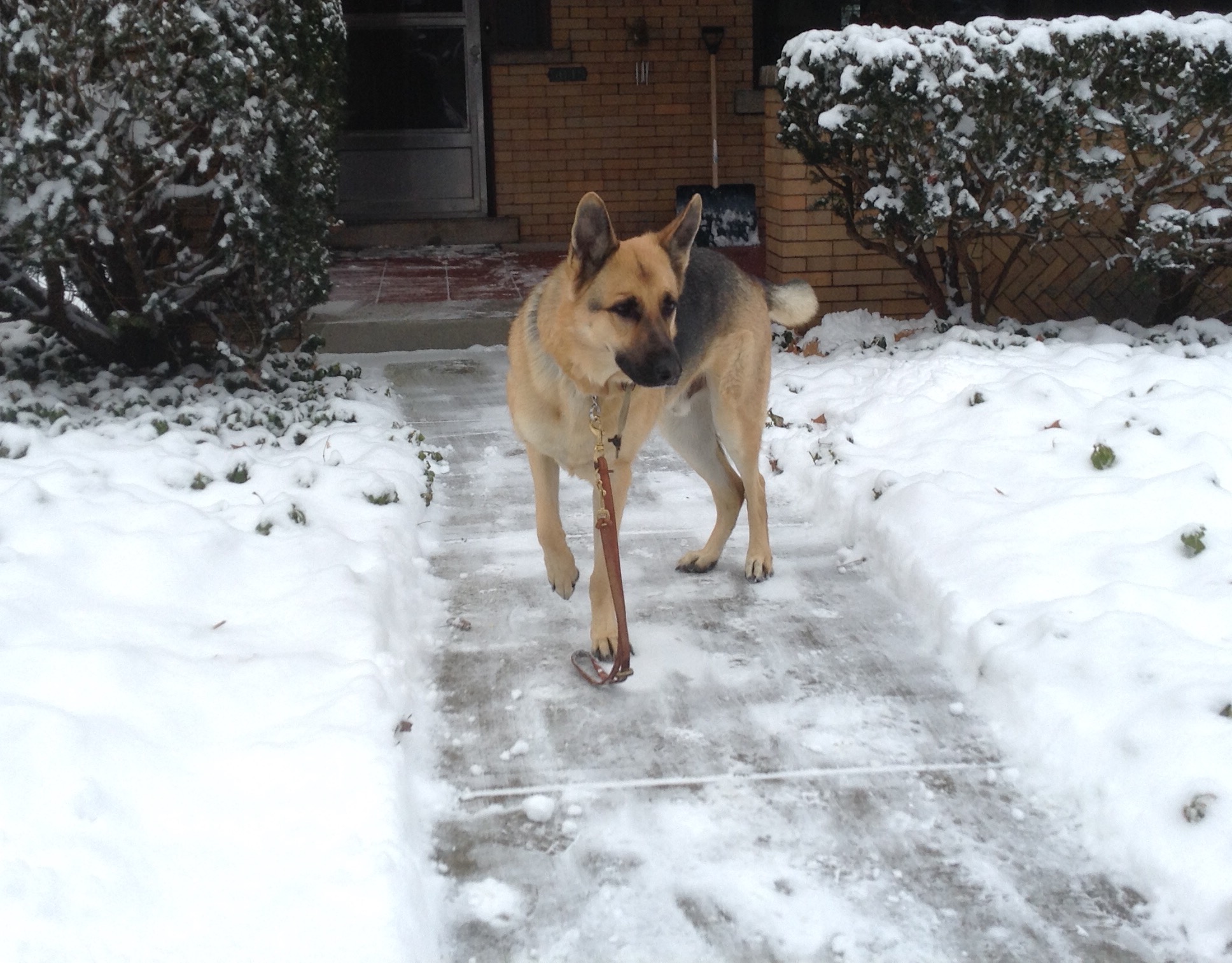
On June 3, 2015 I met my first German shepherd boy, Dave. At twenty months, he still carried his blanket around in his mouth and often lay down with it for comfort. He was my first dog to pay attention to TV and movies. My other dogs just slept, even if dogs barked furiously from the screen. so if the show was scary or “R” rated, we muted the sound and tried to distract him with a toy.
Dave had giardia when I brought him home from Seeing Eye, but even after the medicine cured that problem, he still had stomach pain. One day out of seven he lay on his huge doggie bed and refused to eat or play; he didn’t want to guide me. For nine months, he underwent tests, but nothing explained the problem. I lost sleep, worrying that he wouldn’t be able to continue guiding me. Finally, we discovered that Dave had a simple food allergy, and presto; Dave was fine. He wolfed down his food and zipped me everywhere. Soon, his 75 pounds expanded to a muscular 92-pound frame.
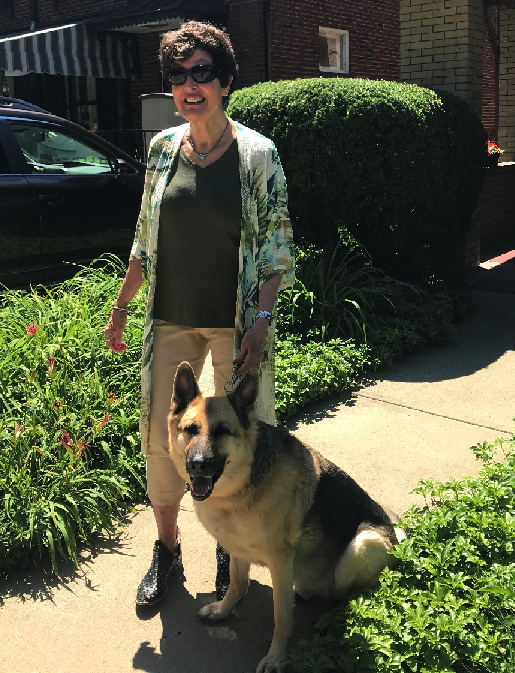
Dave is my most mellow dog, the easiest guide with other animals, with new people, in new places. He’s my largest and strongest dog who truly gives me a work-out. His two passions are a new squeaking tennis ball and his huge dog pillow. Dave traps a portion of his soft pillow between his front paws, then sucks on it like a thumb. He is so silly, but nearly perfect in his behavior and temperament and overwhelmingly cute.
On January 5, 2023, we took Dave to a vet appointment to check the arthritis in his front legs. The vet took a routine Xray, which shocked all of us. It showed a tumor in Dave’s spleen that was possible cancer. Bob and I rushed to the cancer specialist who tested Dave. She found that he had a blood vessel cancer, spreading rapidly. With chemotherapy, Dave might live at most six months. Without any treatment, he could die overnight. The vet didn’t recommend chemo because of its many unpleasant side effects. Though deeply sad, Bob and I decided to euthanize him that afternoon, something that just broke our hearts.
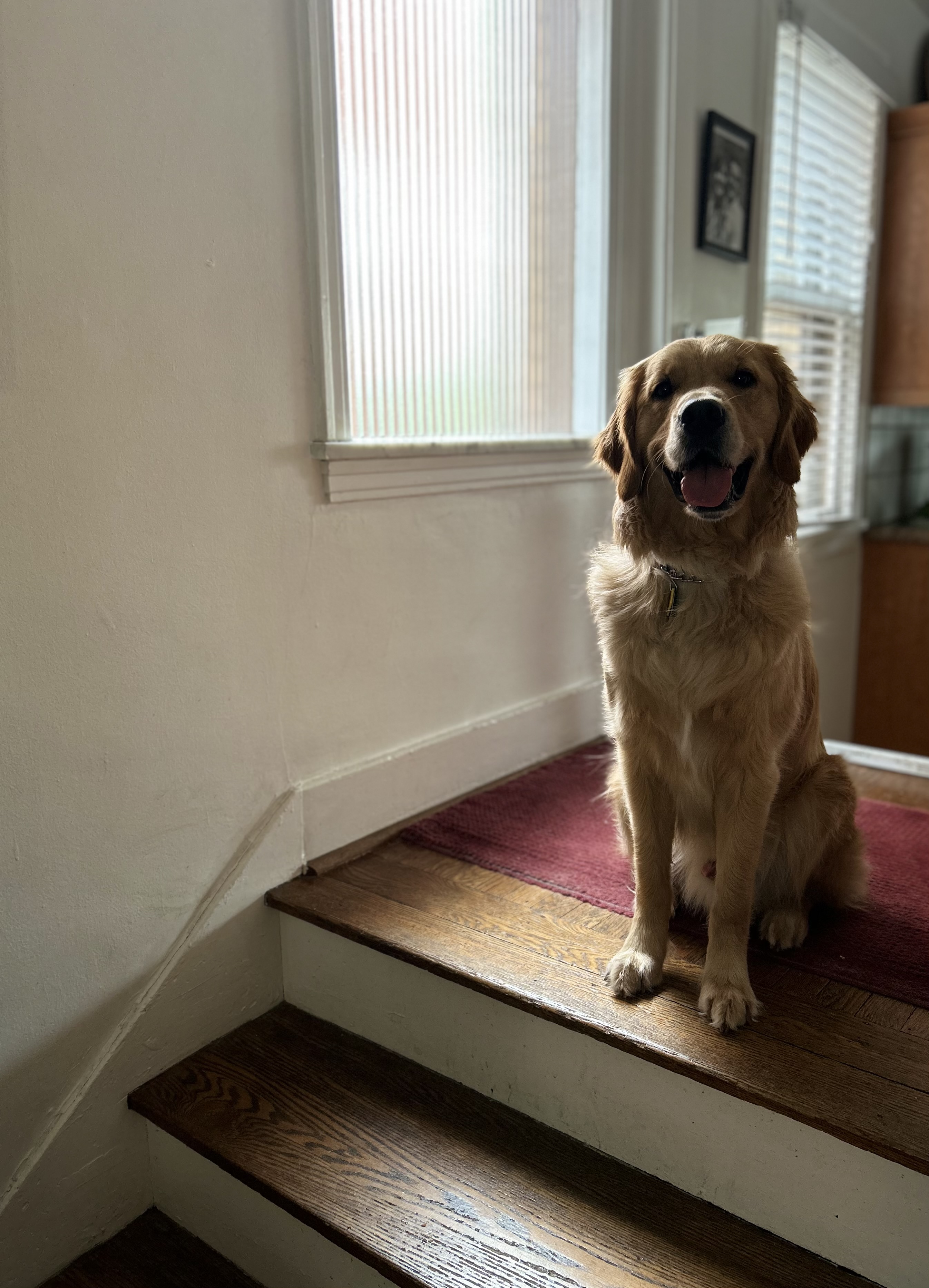
Fourteen months later, a Seeing Eye trainer arrived in Pittsburgh with my very first golden retriever, a boy named Ozzy, 68 pounds, born March 28, 2022. From the first meeting, I understood that Ozzy was cuddly, mellow, loving, with as beautiful a spirit as Dave had had. Ozzy’s head is constantly on my foot, or knee; he uses his paw to pull my hand to pat and scratch him.
Ozzy loves nature, and often steals a leaf or flower from a bush or snatches some mulch from a garden. He loves all animals, birds, squirrels, cats, and other dogs; in harness, he fights the urge to leap at them and usually succeeds. Walking up our back steps, he always sticks his head through the gap in the railing to watch the squirrels and birds in our yard.
After eight days of training, I tried Ozzy on a solo walk that should have taken 25 minutes, but really took an hour. We departed about 9:00 on a Sunday morning with absolutely no other pedestrians and almost no vehicle traffic. Ozzy suddenly stopped and turned 90 degrees, but I didn’t think we were at an intersection or an obstacle. After checking out the terrain, I decided to turn back and go home the way we’d come. But soon, nothing felt or sounded right. I reached into my pocket to phone my husband, only then realizing I’d forgotten my cell. I kept walking, hoping that I’d recognize a sound or tactile clue. Possibly a pedestrian would come by, or I’d flag down a car. Three cars came along, actually, and I waved; they beeped back, probably thinking I was being friendly. Finally, at an intersection, a car slowed. I bent and cupped my hands around my mouth, calling, “May I speak to you?”
Amazingly, two of my dearest friends were in the car enroute to church. They purposely had been ignoring me, so they wouldn’t interfere with training.
Fortunately, they gave me my bearings and called Bob, and Ozzy and I returned home safely.
After two months of identifying tactile and auditory clues, I have nearly 100% perfect solo trips with Ozzy. He is so proud of himself and actually struts. Our hard work has paid off, and I am indebted to the wonderful trainers who taught my sixth guide dog his skills.